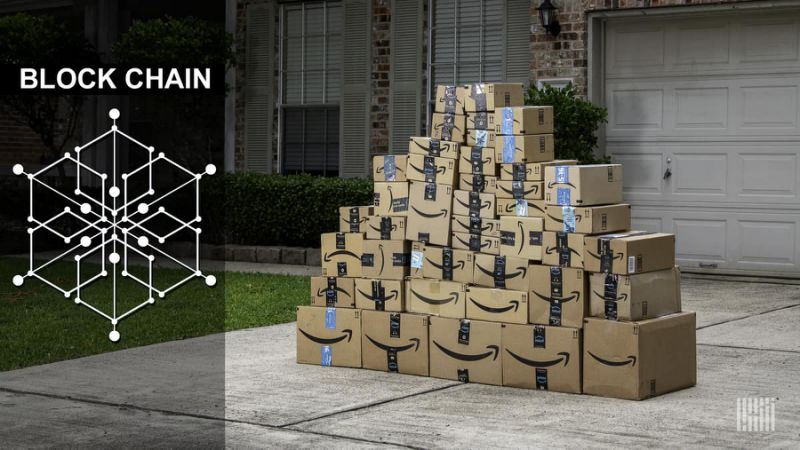
The patent acknowledges the rapid increase of “systems and databases that can often lack transparency, coherency, referential integrity or security,” and explains how the reliably immutable nature of blockchain will ensure that consumer goods sold on Amazon’s e-commerce site are authentic.
<p class="canvas-atom canvas-text Mb(1.0em) Mb(0)–sm Mt(0.8em)–sm" type="text" content="Lack of trust is a bête noire for Amazon, where thousands of fraudulent, unsafe or mislabeled products continue to be listed on the site. A Wall Street Journal investigation last fall revealed that Amazon has listed "thousands of banned, unsafe, or mislabeled products," from dangerous children’s products to electronics with fake certifications. In another high-profile reveal, CNBC found that Amazon has shipped expired foods — including baby formula — to customers.” data-reactid=”25″>Lack of trust is a bête noire for Amazon, where thousands of fraudulent, unsafe or mislabeled products continue to be listed on the site. A Wall Street Journal investigation last fall revealed that Amazon has listed “thousands of banned, unsafe, or mislabeled products,” from dangerous children’s products to electronics with fake certifications. In another high-profile reveal, CNBC found that Amazon has shipped expired foods — including baby formula — to customers.
<p class="canvas-atom canvas-text Mb(1.0em) Mb(0)–sm Mt(0.8em)–sm" type="text" content="Blaming the prevalence of counterfeits, companies such as Birkenstock and Nike have pulled out of the Amazon marketplace.” data-reactid=”26″>Blaming the prevalence of counterfeits, companies such as Birkenstock and Nike have pulled out of the Amazon marketplace.
Blockchain may woo them back.
Amazon didn’t immediately respond to a request for comment.
<p class="canvas-atom canvas-text Mb(1.0em) Mb(0)–sm Mt(0.8em)–sm" type="text" content="Without trust, there is nothing ” data-reactid=”29″>Without trust, there is nothing
But in the description section of the patent, Amazon explains that the system aims to improve trust “through an enterprise services platform that allows parties to map their global supply chains.”
“Trust is earned,” it proclaimed. “Once trust is lost, it can often be difficult to regain.”
Amazon’s solution would enable manufacturers, couriers, distributors and end-users, among others, to gain real-time visibility of the item as it moves through the supply chain.
Consumers would get access to the data, as whimsically represented in one of the patent drawings.

<p class="canvas-atom canvas-text Mb(1.0em) Mb(0)–sm Mt(0.8em)–sm" type="text" content="Image: Amazon patent filing” data-reactid=”41″>Image: Amazon patent filing
“When an item is added to a catalog system, the item information may be included in the creation element at the start of the ledger for the item,” the patent states. “A certification authority may be included to verify that items received correspond to the item included in the catalog based on one or more certification rules.”
The certification authority could also apply rules for testing and certification, such as ensuring item quality through the supply chain or requiring certain certification steps before the item can continue moving forward.
<p class="canvas-atom canvas-text Mb(1.0em) Mb(0)–sm Mt(0.8em)–sm" type="text" content="Another stage in the visibility quest” data-reactid=”44″>Another stage in the visibility quest
<p class="canvas-atom canvas-text Mb(1.0em) Mb(0)–sm Mt(0.8em)–sm" type="text" content="In recent years, blockchain-based use cases have found significant traction within the freight industry. The technology decentralizes information and stores it in an immutable ledger accessible by every stakeholder in the logistics process, accelerating industry-wide collaboration and improving supply chain efficiency.” data-reactid=”45″>In recent years, blockchain-based use cases have found significant traction within the freight industry. The technology decentralizes information and stores it in an immutable ledger accessible by every stakeholder in the logistics process, accelerating industry-wide collaboration and improving supply chain efficiency.
Blockchain applications represent “the evolution of existing solutions to supply chain challenges that aren’t ever going to go away,” explained Patrick Duffy, president of the Blockchain in Transportation Alliance (BiTA).
At its core, the digital ledger is a supplementation of visible technology track-and-trace and asset provenance, Duffy said. “It’s a further evolution of technology trying to solve for the same question: ‘Where’s my stuff? What’s its condition?'”
Add to those questions: Is it real? Last year, Amazon launched a counterfeit detection initiative, Project Zero, designed to intercept fake goods. The blockchain technology would in all likelihood aid in that effort, ensuring “digital trust from the first mile of an item’s supply chain” to its destination, according to the patent.
<p class="canvas-atom canvas-text Mb(1.0em) Mb(0)–sm Mt(0.8em)–sm" type="text" content="Read more FreightWaves articles by Linda Baker.” data-reactid=”49″>Read more FreightWaves articles by Linda Baker.
<p class="canvas-atom canvas-text Mb(1.0em) Mb(0)–sm Mt(0.8em)–sm" type="text" content="See more from Benzinga” data-reactid=”50″>See more from Benzinga
<p class="canvas-atom canvas-text Mb(1.0em) Mb(0)–sm Mt(0.8em)–sm" type="text" content="© 2020 Benzinga.com. Benzinga does not provide investment advice. All rights reserved.” data-reactid=”55″>© 2020 Benzinga.com. Benzinga does not provide investment advice. All rights reserved.












Add Comment